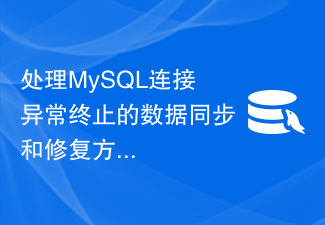 Backend Development
Backend Development PHP Tutorial
PHP Tutorial How to implement synchronous and asynchronous data processing functions in PHP
How to implement synchronous and asynchronous data processing functions in PHP
How to implement synchronous and asynchronous data processing functions in PHP
With the continuous development of the Internet, real-time updates of web pages and asynchronous processing of data have become increasingly important The more important it is. As a popular back-end development language, PHP also needs to be able to handle synchronous and asynchronous requests for data. This article will introduce how to implement synchronous and asynchronous data processing functions in PHP and provide specific code examples.
1. Synchronous processing of data
Synchronous processing of data means that after the request is sent, wait for the server to complete processing and return the data before continuing to the next step. The following is a simple PHP code example that shows how to process data synchronously:
<?php
// 发送同步请求
$response = file_get_contents('https://api.example.com/data');
// 处理返回的数据
$data = json_decode($response, true);
// 打印结果
print_r($data);
?> In the above example, we use the file_get_contents function to send a synchronous request and store the returned data in Variable $response. We then use the json_decode function to decode the returned JSON format data into a PHP array and store it in the variable $data. Finally, we output the results to the page through the print_r function.
2. Asynchronous processing of data
Asynchronous processing of data means that after the request is sent, the next step can be continued without waiting for the server to complete processing. The following is a simple PHP code example that shows how to process data asynchronously:
<?php // 创建新的cURL资源 $curl = curl_init(); // 设置请求的URL和参数 curl_setopt($curl, CURLOPT_URL, 'https://api.example.com/data'); // 将结果以字符串形式返回,而不是直接输出 curl_setopt($curl, CURLOPT_RETURNTRANSFER, 1); // 发送异步请求 $response = curl_exec($curl); // 关闭cURL资源 curl_close($curl); // 处理返回的数据 $data = json_decode($response, true); // 打印结果 print_r($data); ?>
In the above example, we first create a new cURL resource using the curl_init function and use curl_setoptThe function sets the requested URL and other parameters. We then use the curl_exec function to send an asynchronous request and store the returned result in the variable $response. Finally, we use the curl_close function to close the cURL resource, and then decode and print the returned data.
3. The choice of synchronization and asynchronousness
In practical applications, we need to choose synchronous or asynchronous methods to process data according to specific needs.
If you need to obtain data during the page loading process, and the acquisition of data will not affect the loading speed of the page, you can choose to process the data synchronously. The synchronization method is simple and intuitive, and the code is relatively simple to write.
If you need to obtain data during the page loading process, and the acquisition of data will affect the loading speed of the page, or some time-consuming data processing operations are required, then you need to choose an asynchronous method to process the data. The asynchronous method can improve the loading speed of the page and also provide a better user experience.
Summary:
In PHP, we can use synchronous and asynchronous methods to process data. Synchronous data processing is suitable for scenarios where data requests have no impact on page loading speed, while asynchronous data processing is suitable for scenarios where page loading speed needs to be improved and time-consuming data processing operations are performed. Through the code examples provided in this article, we hope to help readers understand how to implement synchronous and asynchronous data processing functions in PHP to better meet actual needs.
The above is the detailed content of How to implement synchronous and asynchronous data processing functions in PHP. For more information, please follow other related articles on the PHP Chinese website!
 在Go语言中使用MySQL实现数据的复制和同步Jun 18, 2023 am 08:21 AM
在Go语言中使用MySQL实现数据的复制和同步Jun 18, 2023 am 08:21 AM随着互联网应用的发展和采用的技术不断更新,数据的复制和同步也越来越成为了很多系统所必备的功能。在Golang语言中,很多人都希望使用MySQL数据库来进行数据的复制和同步。本文将介绍如何在Go语言中使用MySQL实现数据的复制和同步。确定复制和同步的需求在开始实现数据的复制和同步之前,我们需要先确定数据的复制和同步的需求。比如,我们需要知道哪些表需要进行数据
 PHP和SOAP:如何实现数据的同步和异步处理Jul 28, 2023 pm 03:29 PM
PHP和SOAP:如何实现数据的同步和异步处理Jul 28, 2023 pm 03:29 PMPHP和SOAP:如何实现数据的同步和异步处理引言:在现代Web应用程序中,数据的同步和异步处理变得越来越重要。同步处理指的是一次只处理一个请求,并等待该请求完成后再处理下一个请求;而异步处理则是同时处理多个请求,并不等待某个请求的完成。在本文中,我们将介绍如何使用PHP和SOAP来实现数据的同步和异步处理。一、SOAP简介SOAP(SimpleObjec
 使用Gin框架实现数据同步和备份功能Jun 22, 2023 am 09:40 AM
使用Gin框架实现数据同步和备份功能Jun 22, 2023 am 09:40 AM随着数据量不断增大,在数据管理和备份方面,已经变得越来越重要。而在现代的互联网应用中,使用Gin框架实现数据同步和备份功能已经成为一个重要的部分。Gin框架是一个轻量级的Go语言Web框架,采用了MVC(模型-视图-控制器)的设计模式,旨在简化Web应用程序的开发。使用Gin框架开发的Web应用可以快速高效地处理HTTP请求和响应,并且具有高度的可扩展性和可
 如何使用Java编写CMS系统的数据同步模块Aug 08, 2023 pm 11:49 PM
如何使用Java编写CMS系统的数据同步模块Aug 08, 2023 pm 11:49 PM如何使用Java编写CMS系统的数据同步模块引言:随着信息时代的发展和互联网的普及,内容管理系统(CMS)在各行各业中得到了广泛的应用。在不同的用户群体中,对内容进行管理需要涉及到多个数据源的同步,这就需要一个高效可靠的数据同步模块来实现。本文将介绍如何使用Java编写CMS系统的数据同步模块,并提供相关的代码示例。一、概述数据同步是指将多个数据源之间的数据
 如何使用PHP数据库连接实现数据的同步和复制Sep 08, 2023 pm 02:54 PM
如何使用PHP数据库连接实现数据的同步和复制Sep 08, 2023 pm 02:54 PM如何使用PHP数据库连接实现数据的同步和复制在许多Web应用程序中,数据的同步和复制是非常重要的。例如,当您有多个数据库服务器时,您可能需要确保这些服务器上的数据保持同步,以便用户在访问应用程序时始终获取最新的数据。幸运的是,使用PHP数据库连接,您可以轻松地实现数据的同步和复制。本文将介绍使用PHP数据库连接实现数据同步和复制的步骤,并提供相应的代码示例供
 MySQL中设置数据复制的镜像技巧Jun 15, 2023 am 11:03 AM
MySQL中设置数据复制的镜像技巧Jun 15, 2023 am 11:03 AMMySQL是一个非常流行的关系型数据库管理系统,它具有良好的性能和稳定性,是众多企业和组织广泛使用的数据库软件。在MySQL中,数据复制是非常重要的特性,它可以让数据在多个数据库服务器之间进行同步,保证数据的安全性和可靠性。设置MySQL数据复制的镜像技巧是本文要介绍的主题。MySQL数据复制的基本概念在MySQL中,数据复制是指将一个MySQL实例中的数据
 处理MySQL连接异常终止的数据同步和修复方法?Jun 30, 2023 am 09:03 AM
处理MySQL连接异常终止的数据同步和修复方法?Jun 30, 2023 am 09:03 AM如何处理MySQL连接异常终止时的数据同步和修复?当使用MySQL进行数据库操作时,有时候会遇到连接异常终止的情况,这可能会导致数据的不一致性甚至丢失。为了保证数据的完整性和一致性,我们需要采取一系列的措施来处理这种异常情况下的数据同步和修复。一、异常情况的原因分析连接异常终止可能是由于网络问题、服务器故障、操作系统崩溃等原因引起的。这些原因可能会导致未完成
 MySQL中的数据主从复制技术Jun 14, 2023 pm 02:10 PM
MySQL中的数据主从复制技术Jun 14, 2023 pm 02:10 PMMySQL数据库是一种非常流行的关系型数据库管理系统,支持多种数据复制技术,其中较为常用的是主从复制技术。本文将介绍MySQL中的数据主从复制技术,包括原理、实现方法、常见问题及应对措施等方面。一、主从复制技术的原理MySQL中的主从复制技术可以将一个MySQL数据库的数据复制到其他服务器上,以实现数据备份、负载均衡、读写分离等功能。它的基本原理是将主数据库


Hot AI Tools

Undresser.AI Undress
AI-powered app for creating realistic nude photos

AI Clothes Remover
Online AI tool for removing clothes from photos.

Undress AI Tool
Undress images for free

Clothoff.io
AI clothes remover

AI Hentai Generator
Generate AI Hentai for free.

Hot Article

Hot Tools

SublimeText3 English version
Recommended: Win version, supports code prompts!

SAP NetWeaver Server Adapter for Eclipse
Integrate Eclipse with SAP NetWeaver application server.

WebStorm Mac version
Useful JavaScript development tools

SublimeText3 Linux new version
SublimeText3 Linux latest version

MinGW - Minimalist GNU for Windows
This project is in the process of being migrated to osdn.net/projects/mingw, you can continue to follow us there. MinGW: A native Windows port of the GNU Compiler Collection (GCC), freely distributable import libraries and header files for building native Windows applications; includes extensions to the MSVC runtime to support C99 functionality. All MinGW software can run on 64-bit Windows platforms.





